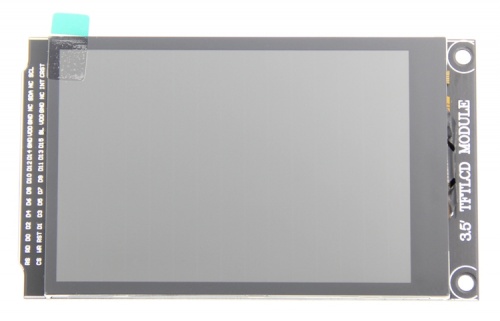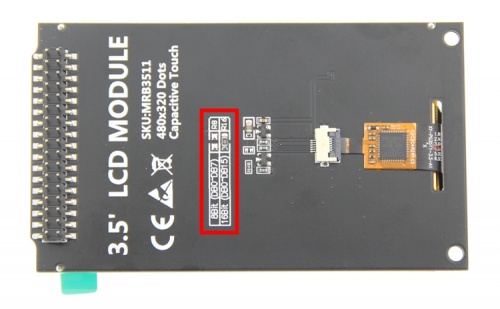More actions
Product Picture
Product Description
- 3.5-inch color screen, support 16BIT RGB 65K color display
- 320x480 resolution for clear display
- With capacitive touch screen for 5-point touch
- Support 8-bit/16-bit parallel data bus mode switching (16 bits by default)
- Military-grade process standards, long-term stable work
- Support punctual atom full range of development board inline, provide routines
- Provide STM32/C51 source code, WIKI data online update
- Provide underlying driver technical support
Product Parameters
| Name | Parameter |
| Display Color | 16BIT RGB 65K color |
| SKU | MRB3511 |
| Screen Size | 3.5(inch) |
| Screen Type | TFT |
| Driver IC | ILI9488 |
| Resolution | 320*480 (Pixel) |
| Module Interface | 8Bit or 16Bit parallel interface |
| Active Area | 48.96x73.44 (mm) |
| Touch Screen Type | Capacitive touch screen (maximum support for 5 touches) |
| Touch IC | GT911 |
| Module PCB Size | 56.41x97.60 (mm) |
| Operating Temperature | -10℃~60℃ |
| Storage Temperature | -20℃~70℃ |
| Operating Voltage | 3.3V/5V |
| Power Consumption | TBD |
| Rough Weight | 57g |
Interface Definition

|

|
|---|---|
| Picture1. Module Pin silk screen picture | Picture2. Module rear view |
The module hardware supports 8-bit and 16-bit parallel port data bus mode switching (shown in red box in Picture 2), as follows:
- Solder R16 with 0Ω resistor or short circuit directly, and disconnect R8: Select 16-bit parallel port data bus mode, use DB0~DB15 data pins(default)
- Solder R8 with 0Ω resistor or short circuit directly, and disconnect R16: Select 8-bit parallel port data bus mode, use DB0~DB7 data pins
| Number | Module Pin | Pin Description |
| 1 | CS | LCD reset control pin( low level enable) |
| 2 | RS | LCD register / data selection control pin(high level: register, low level: data) |
| 3 | WR | LCD write control pin |
| 4 | RD | LCD read control pin |
| 5 | RST | LCD reset control pin( low level reset) |
| 6 | DB0 | LCD data bus low 8-bit pin |
| 7 | DB1 | |
| 8 | DB2 | |
| 9 | DB3 | |
| 10 | DB4 | |
| 11 | DB5 | |
| 12 | DB6 | |
| 13 | DB7 | |
| 14 | DB8 | LCD data bus high 8-bit pin(When using the 8-bit parallel port data bus mode, the upper 8-bit pin is not used.) |
| 15 | DB9 | |
| 16 | DB10 | |
| 17 | DB11 | |
| 18 | DB12 | |
| 19 | DB13 | |
| 20 | DB14 | |
| 21 | DB15 | |
| 22 | GND | Module power ground pin |
| 23 | BL | LCD backlight control pin(High level light) |
| 24 | VDD | Module power positive pin (module has integrated voltage regulator IC, so the power supply can be connected to 5V or 3.3V) |
| 25 | VDD | |
| 26 | GND | Module power ground pin |
| 27 | GND | |
| 28 | NC | LCD backlight power positive pin (default shared onboard backlight power supply, this pin can not be connected) |
| 29 | NC | Not defined, no need to use |
| 30 | SDA | Capacitive touch screen IIC bus data pin |
| 31 | INT | Capacitive touch screen interrupt detection pin (low level when a touch occurs) |
| 32 | NC | Not defined, no need to use |
| 33 | CRST | Capacitive touch screen IC reset control pin (low level reset) |
| 34 | SCL | Capacitive touch screen IIC bus clock pin |
How to use on STM32 development board
This module is compatible with the ALIENTEK STM32 development board. The specific usage is as follows:
- Step 1: Download the test program
- Download the STM32 test program from the Program Download column
- For a description of the relevant test procedures, please refer to the test program documentation in the package
- Step 2: Connect the STM32 development board
- Find the TFTLCD Slot on the development board, connect the module pins and Slot(For example, the module CS pin corresponds to the slot CS pin),
- and then plug them directly into the Slot
- Step 3: Compile and download the program to the development board
- Compile and download the program you need to test to the STM32 development board( Don't know how to compile and download?)
- Step 4: Observe the running of the program
- After the program is finished, observe the running status of the program. If it can be displayed normally, the program runs successfully.
Program Download
Product Documentation
- 3.5inch 8&16bit Parallel-Port Capacitive Module User Manual
- 3.5inch TFT LCD Specification
- 3.5inch Capacitive Touch structure engineering drawing
- 3.5inch 8&16bit Parallel-Port Capacitive Module Size
- 3.5inch 8&16bit Parallel-Port Capacitive Module Schematic
- 3.5inch 8&16bit Parallel-Port Capacitive Module LCD Schematic and PCB Package Library
- Driver IC ILI9488 Data sheet
Reference Materials
- C51 Keil and stc-isp software use illustration
- STM32 keil software use illustration
- PCtoLCD2002 software use illustration
- Image2Lcd software use illustration
- Chinese and English display modulo settings
